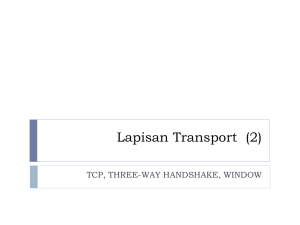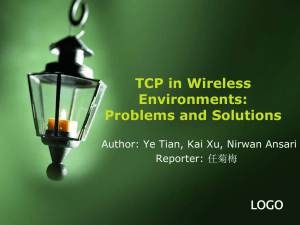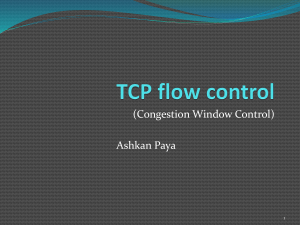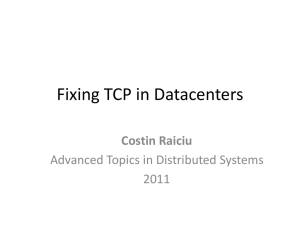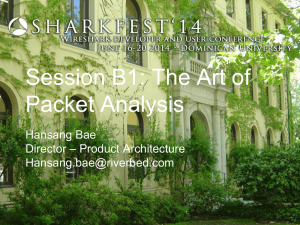Chapter 5 Transport Layer
advertisement
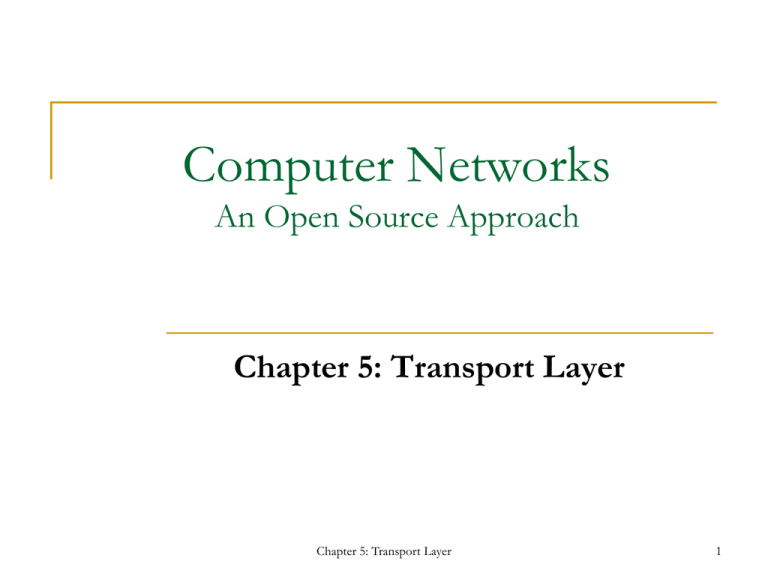
Computer Networks
An Open Source Approach
Chapter 5: Transport Layer
Chapter 5: Transport Layer
1
Content
5.1 General Issues
5.2 UDP - Unreliable Connectionless Transfer
Port-Multiplexing
5.3 TCP - Reliable Connection-Oriented Transfer
Port-Multiplexing, Reliability, Flow/Congestion Control
Connection Management
Reliability
Flow Control
Performance Enhancements
5.4 Socket Programming Interface
5.5 Real-time Transport (RTP & RTCP)
5.6 Summary
Chapter 5: Transport Layer
2
5.1 General Issues
End-to-End
Communication Channel
Data Integrity
Flow Control
Socket Programming Interface
Chapter 5: Transport Layer
3
5.1 General Issues
End-to-End Communication Channel: PortMultiplexing
Port: communication end point
IP
MAC
IP
Multi-Access
Channel
LAN host 1
AP1
AP2
TCP/UDP
MAC
LAN host 2
AP1
IP Network
AP2
TCP/UDP
IP host 1
IP host 2
Condense delay distribution
Loose delay distribution
Node-to-Node Channel
End-to-End Channel
Chapter 5: Transport Layer
4
General Issues: Direct-Linked vs. End-toEnd
Direct-Linked Protocol Layer
End-to-End Protocol Layer
physical layer
internetworking layer
base on what services?
services
addressing
node-to-node channel within a link.
(MAC address)
process-to-process channel
between hosts (port number)
error checking
per-frame
per-segment
data reliability
per-link
per-flow
flow control
per-link
per-flow
condensed distribution
loose distribution
channel delay
Note: per-frame integrity such as Ethernet
Collision: can be detected and be retransmitted
CRC/alignment error: can only rely on upper-layer protocols
Chapter 5: Transport Layer
5
Open Source Implementation 5.1:
an incoming packet in the transport layer
Application
layer
recvfrom
raw_recvmsg (sk, buf)
read
sys_socketcall
sys_read
sys_recvfrom
vfs_read
sock_recvmsg
do_sync_read
__sock_recvmsg
sock_aio_read
sock_common_recvmsg
do_sock_read
udp_recvmsg (sk,buf)
skb_recvdatagram
skb=skb_dequeue
sock_recvmsg
tcp_recvmsg(sk,buf)
skb_copy_datagram_iovec
sk->sk_data_ready
sk_receive_queue
__skb_queue_tail(sk->sk_receive_queue, skb)
socket_queue_rcv_skb(sk,skb)
tcp_data_queue(sk,skb)
tcp_rcv_established
raw_rcv_skb(sk,skb)
raw_rcv(sk,skb)
sk=__raw_v4_lookup(skb)
udp_queue_rcv_skb(sk,skb)
tcp_v4_do_rcv(sk,skb)
sk=udp_v4_lookup(skb)
sk=inet_lookup(skb)
raw_v4_input(skb)
RAW
udp_rcv(skb)
tcp_v4_rcv(skb)
TCP
UDP
io_local_deliver_finish
Copyright
Reserved 2009
Chapter
5: Transport
Layer
Transport
layer
Network
layer
6
Open Source Implementation 5.1:
an outgoing packet in the transport layer
Application
layer
raw_sendmsg(sk,buf)
sendto
write
sys_socketcall
sys_write
sys_sendto
vfs_write
sock_sendmsg
do_sync_write
inet_sendmsg
sock_aio_write
udp_sendmsg(sk,buf)
do_sock_write
ip_append_data(sk, buf)
skb=sock_wmalloc(sk)
sock_sendmsg
skb=sock_alloc_send_skb(sk)
inet_sendmsg
ip_generic_getfrag
tcp_sendmsg(sk,buf)
skb_queue_tail(&sk->sk_write_queue,skb)
sk_write_queue
udp_push_pending_frames
ip_push_pending_frames
tcp_push
__tcp_push_pending_frames
tcp_write_xmit
tcp_transmit_skb
dst_output
ip_queue_xmit
skb->dst->output
ip_output
Copyright
Reserved 2009
Chapter
5: Transport
Layer
Transport
layer
Network
layer
7
5.2 UDP – Unreliable
Connectionless Transfers
Objectives
Header
Format
Unicast Real-time Applications Using UDP
Chapter
Copyright
5: Transport
Reserved 2009
Layer
8
5.2 UDP – For Unreliable Connectionless
Transfers
Objectives
Port-Multiplexing
AP1
AP2
TCP
AP1
IP Networks
IP host 1
AP2
TCP
IP host 2
Per-Segment Error Checking: Checksum
Header Format 0
15 16
31
source port number
destination port number
UDP length
UDP checksum (optional)
8 bytes
~
~
data (if any)
~
~
Carrying Unicast/Multicast Real-Time Traffic
Retransmission is Meaningless: No Per-Flow Integrity Needed
Bit-rate is Determined by Codec Used: No Flow Control Needed
Copyright
Reserved 2009
Chapter
5: Transport
Layer
9
Open Source Implementation 5.2: UDP
and TCP Checksum
th->check = tcp_v4_check(len, inet->saddr,
inet->daddr,
csum_partial((char *)th,
th->doff << 2,
skb->csum));
Checksum in TCP/IP
In Linux 2.6:
ip_send_check(iph)
tcp_v4_check(T, lenT, SA, DA, csum)
Pseudo Header
csum=csum_partial(T,lenT,csum)
csum=csum_partial(D,lenD,0)
IP Header
TCP/UDP Header
Copyright
Reserved 2009
Chapter
5: Transport
Layer
Application Data
10
5.3 TCP – Reliable ConnectionOriented Transfers
Objectives
Connection
Management
Per-Flow Data Integrity
Per-Flow Flow/Congestion Control
Performance Problems and Enhancements
Chapter
Copyright
5: Transport
Reserved 2009
Layer
11
5.3 TCP – For Reliable ConnectionOriented Transfers
Objectives
Connection Establishment/Disconnection & State Transitions
Per-Flow Data Integrity
Stateful (Ch1) !! Requires
connection management
Connection Management
Port-Multiplexing: Same as UDP
Per-Flow Reliability
Per-Flow Flow Control
Per-Frame Checksum & Per-Flow ACKs
Per-Flow Flow/Congestion Control
Performance
Interactive vs. Bulk-Data Transfers
Copyright
Reserved 2009
Chapter
5: Transport
Layer
12
TCP Connection Management
Establishment/Termination – 3-Way
Handshake Protocol
Establishment
client
Termination
server
client
server
F IN
SYN (seq=
x)
ACK of FIN
eq=y)
SYN (s (ack=x+1)
SYN
A C K of
(seq=x)
A C K of S
YN (ack=
y+1)
FIN
A C K of F
Copyright
Reserved 2009
Chapter
5: Transport
Layer
IN
13
TCP State Transition Diagram
CLOSED
server
client
app: passive open
send: nothing
timeout
send: RST
: SY
recv
N
:
send
,A
SYN
: RS
recv
CK
LISTEN
app
:
sen send
d
d:
SY ata
N
T
recv: SYN
send: SYN, ACK
simultaneous open
SYN_RCVD
app: close
send: FIN
re
sen cv: A
d:
not CK
hin
g
ESTABLISHED
recv: ACK
send: nothing
SYN_SENT
app: close
or timeout
active open
CK
N, A
Y
S
:
K
recv nd: AC
se
e
clos
app: : FIN
send
FIN_WAIT_1
ap
p:
se acti
nd ve
: S op
YN en
recv: FIN
send: ACK
rec
v
sen : FIN
,
d:
not ACK
hin
g
recv: FIN
send: ACK
CLOSE_WAIT
data transfer state
simultaneous close
CLOSING
app: close
send: FIN
LAST_ACK
recv: ACK
send: nothing
recv: ACK
send: nothing
passive close
FIN_WAIT_2
recv: FIN
send: ACK
TIME_WAIT
active close
Copyright
Reserved 2009
Chapter
5: Transport
Layer
14
State Transitions: Establishment
client
server
LISTEN
CLOSED
SYN_SENT
SYN (seq=
x)
=y)
q
e
s
(
N
1)
+
SY
x
=
k
c
N (a
Y
S
f
o
A CK
ESTABLISHED
A C K of S
(seq=x)
YN (ack=
y+1)
Chapter 5: Transport Layer
SYN_RCVD
ESTABLISHED
15
State Transitions: Termination
client
server
ESTABLISHED
FIN_WAIT_1
ESTABLISHED
F IN
A C K o f F IN
FIN_WAIT_2
CLOSE_WAIT
LAST_ACK
F IN
TIME_WAIT
2MSL timeout
A C K of F
IN
CLOSED
CLOSED
Chapter 5: Transport Layer
16
State Transitions: Simultaneous
Open/Close
client
server
CLOSED
SYN_SENT
SYN_RCVD
ESTABLISHED
SYN (seq=
x)
S Y N (s
SYN (seq=
x)
A CK o f S
YN (ack=
y+1)
1)
)
=y ck=x+
q
e
s
a
N(
N(
S Y of S Y
K
AC
eq=y)
client
LISTEN
ESTABLISHED
SYN_SENT
FIN_WAIT_1
SYN_RCVD
CLOSING
ESTABLISHED
server
ESTABLISHED
F IN
A CK
2MSL timeout
CLOSED
(a) state transitions in simultaneous open
FIN_WAIT_1
A C K of F
TIME_WAIT
FIN
o f F IN
IN
CLOSING
TIME_WAIT
2MSL timeout
CLOSED
(b) state transitions in simultaneous close
Chapter 5: Transport Layer
17
State Transitions : Loss in Establishment
client
LISTEN
CLOSED
SYN_SENT
client
server
SYN (seq=
x)
LISTEN
CLOSED
SYN (seq=
SYN_SENT
timeout
timeout
CLOSED
server
x)
eq=y)
SYN (s (ack=x+1)
SYN
A C K of
SYN_RCVD
timeout
CLOSED
RS T
CLOSED
LISTEN
CLOSED
(a) SYN sent by the client is
lost
(b) SYN sent by the server
is lost
client
server
LISTEN
CLOSED
SYN_SENT
ESTABLISHED
SYN (seq=
x)
eq=y)
SYN (s (ack=x+1)
SYN
A C K of
(seq=x+1)
A C K of S
YN (ack=
y+1)
RS T
SYN_RCVD
timeout
CLOSED
LISTEN
CLOSED
(c) ACK of SYN sent by
the client is lost
Chapter 5: Transport Layer
18
TCP State Transition Implementation
In “sock” structure
State names
Copyright
Reserved 2009
Chapter
5: Transport
Layer
19
Reliability of Data Transfers
Definition: Data Reliability vs. Data Integrity
Data Integrity:
Data Reliability:
Successfully received packets are exactly the same as
they are transmitted.
Every transmitted packet is successfully received and is
exactly the same as the original transmitted one.
TCP
Per-Segment Integrity: Checksum
Per-Flow Reliability: Sequence Number & ACK
Copyright
Reserved 2009
Chapter
5: Transport
Layer
20
Per-Flow Data Reliability: Sequence
Number & Acknowledgement
Per-Flow Data Reliability: Sequence Number & ACK
ACK every successfully received data segment
Segment sent but not ACK?
Dropped by some intermediate router
Dropped by the receiver
Insufficient buffer
Forced drop
Wrong checksum
Retransmitting Lost Packets
When to Retransmit Which?
Copyright
Reserved 2009
Chapter
5: Transport
Layer
21
Data Reliability: Cumulative ACK (1/2)
Client
Server
Client
DATA(S
e
DATA(S
e
DATA(S
e
q=100,
Len
X
(Ac
ACK
Timeout
q=150,
Len=30
)
DATA(S
eq=100
, Len
ck
ACK(A
q=150,
Len=30
)
0)
=15
k
c
(A
K
AC
=50)
=180)
time
=50)
DATA(S
e
0)
k=10
Timeout
timeout
q=100,
Len=50
)
Server
)
180
c k=
DATA(S
eq
(A
ACK
=100, Le
n=50)
duplicate data
drop it
80)
k=1
c
A
(
ACK
time
(b) delay
(a) packet loss
Chapter 5: Transport Layer
22
Data Reliability: Cumulative ACK (2/2)
Client
Server
DATA(S
eq=10
Client
)
DATA(S
eq=150,
Len=30)
X
ck
ACK(A
ck
ACK(A
=150)
timeout
timeout
0, Len=5
0
=180)
time
Server
DAT
A(Se
q=10
0, Le
n=50
)
DATA(Seq=1
50, Len=30)
00)
ck=1
A
(
K
AC
0)
k=18
c
A
(
ACK
time
(d) out-of-sequence
(c) ACK loss
Chapter 5: Transport Layer
23
Pseudo Code of Sliding Window in
the Sender
SWS: send window size.
n: current sequence number, i.e., the next packet to be transmitted.
LAR: last acknowledgment received.
if the sender has data to send
Transmit up to SWS packets ahead of the latest acknowledgment LAR,
i.e., it may transmit packet number n as long as n < LAR+SWS.
endif
if an ACK arrives,
Set LAR as ack num if its ack num > LAR.
endif
Chapter 5: Transport Layer
24
Per-Flow Flow/Congestion Control
Sliding Window
Should maintain a out-of-order queue to resequence before returning to application
Receiving byte stream
2
3
4
DATA
ACK
Ack=5
Sending Stream
Receiver
6
ACK
Ack=6
SND_UNA
2
5
DATA
SND_NXT
7
sliding
DATA
Network Pipe
(size=Data 4~8)
8
3
9
Sent & ACKed
TCP Window Size( = min(RWND, CWND) )
10
Sender
To be sent
When window moves
Should maintain a retransmission
queue in case of packet loss
Copyright
Reserved 2009
Chapter
5: Transport
Layer
25
Sliding Window : Normal Case (1/2)
2
3
4
5
ACK
Ack=6
ACK
Ack=5
DATA 7
Network Pipe
DATA 8
sliding
Sending Stream
2
Receiver
DATA 6
3
Sender
To be sent
When window moves
TCP Window Size
= min(RWND, CWND)
Sent & ACKed
(a) Original condition
2
3
4
5
6
ACK
Ack=7
ACK
Ack=6
Sending Stream
2
3
Receiver
DATA 7
DATA 8
DATA 9
sliding
4
Sender
(b) Sender receives ACK(Ack=5)
Chapter 5: Transport Layer
26
Sliding Window : Normal Case (2/2)
2
3
4
5
6
7
ACK
Ack=8
ACK
Ack=7
3
4
DATA 9
DATA
10
sliding
Sending Stream
2
Receiver
DATA 8
5
Sender
(c) Sender receives ACK(Ack=6)
2
3
4
5
6
7
8
DATA 9
ACK
Ack=9
DATA
10
ACK
Ack=8
sliding
Sending Stream
2
3
DATA
11
4
5
6
Sender
(d) Sender receives ACK(Ack=7)
Chapter 5: Transport Layer
27
Sliding Window : Out-of-Sequence(1/2)
2
3
DATA 4
5
Receiver
6
ACK
Ack=4 DATA 7
ACK
Ack=4
Network Pipe
DATA 8
Sending Stream
2
3
Sender
To be sent
When window moves
TCP Window Size
= min(RWND, CWND)
Sent & ACKed
(a) Original condition
2
3
4
5
6
ACK
Ack=7
Receiver
DATA 7
DATA 8
ACK
Ack=4
Sending Stream
2
3
Sender
(b) Sender receives ACK(Ack=4) of DATA 5
Chapter 5: Transport Layer
28
Sliding Window : Out-of-Sequence(2/2)
2
3
4
5
6
7
Receiver
DATA 8
ACK
Ack=8
ACK
Ack=7
Sending Stream
2
3
Sender
(c) Sender receives ACK(Ack=4) of DATA 6
2
3
4
5
6
7
8
ACK
Ack=9
ACK
Ack=8
3
10
sliding
Sending Stream
2
DATA 9 DATA
4
5
6
DATA
11
Sender
(d) Sender receives ACK(Ack=7)
Chapter 5: Transport Layer
29
Per-Flow Flow/Congestion Control
Opening & Shrinking of Window Size
Close
2
Shrink
3
Open
9
10
TCP Window Size( = min(RWND, CWND) )
Copyright
Reserved 2009
Chapter
5: Transport
Layer
30
Retransmitting Lost Packets
Retransmit Which Packet?
Fast Retransmit
Towards Better Accuracy: TCP SACK Option
Further Refinement: FACK (based on SACK)
When to Retransmit?
Fast Retransmit: same as above
Retransmission Timeout (RTO)
Round-Trip Time (RTT) Measurement
Tradeoff: RTT vs. RTO
Karn’s Algorithm
Towards Better RTO: TCP Timestamp Option
Copyright
Reserved 2009
Chapter
5: Transport
Layer
31
Retransmit Which Packet?
3
4
4
4
4
Fast Retransmit
2
3
6
7
8
Packet Reordering
Time at Receiver
Duplicate ACKs
ACK
Packet Loss
Internet Route Change
DATA
2
3
6
7
8
TCP Receiver ACK the First “Hole”
Triple Duplicate ACKs (TDA)
4 Same ACKs (ACK field=X)
TCP Sender Infer TDA as Congestion
Retransmit the Packet with SeqNum=X
Halve Its Sending Rate
Copyright
Reserved 2009
Chapter
5: Transport
Layer
32
When to Retransmit?
Retransmission TimeOut (RTO)
Round-Trip Time (RTT) Measurement vs. RTO
RTT: Varying Dramatically
Smoothed RTT (SRTT) : Exponential Weighted Moving
Average
Mdev: Mean Deviation of RTT
RTO=SRTT+4*Mdev
Karn’s Algorithm
Don’t Update RTO When Retransmission is Also Lost
Copyright
Reserved 2009
Chapter
5: Transport
Layer
33
TCP RTT Estimator
Fast estimator by Van Jacobson ’88 & ‘90
srtt (smoothed rtt) is kept in 8 times RTT
mdev is kept in 4 times the real mean deviation
In tcp_input.c from Linux 2.6:
exponential weighted moving average
Copyright
Reserved 2009
Chapter
5: Transport
Layer
34
Per-Flow Flow/Congestion Control
How Fast to Send?
Fast Sender vs. Slow Receiver
How to Know?
Fast Sender vs. Congested Network
How to Know?
Feedback RWND (Receiver Advertised Window) in ACK by
Receiver
Feedback Loss Events by Network
Re-adjust (Congestion Window) CWND
How Fast?
Satisfy Both: min (RWND, CWND)
Copyright
Reserved 2009
Chapter
5: Transport
Layer
35
TCP Tahoe Congestion Control
Fast
retransmit
≧3 duplicate ACK
≧3 duplicate ACK
cwnd=cwnd+1
ACK
send packet
Slow start
send missing packet
ssth=cwnd/2
cwnd=1
send data packet
cwnd=cwnd+ 1/ cwnd
ACK
Congestion
avoidance
cwnd ≧ ssth
start
timeout
timeout
all ACKed
Retransmission
timeout
cwnd=1
Chapter 5: Transport Layer
36
Slow Start & Congestion Avoidance
Slow Start
source
destination
Congestion Aviodance
source
Copyright
Reserved 2009
Chapter
5: Transport
Layer
destination
37
An example: TCP Tahoe (1/2)
38 37 36 35 34 33 32 31
(1) S
cwnd=8
awnd=8
(2) S
cwnd=8
awnd=8
Chapter 5: Transport Layer
D
Sender sent segment 31-38
D
Receiver replied seven
duplicate ACKs of segment
30
38
An example: TCP Tahoe (2/2)
D
Sender received three
duplicate ACKs and cwnd is
changed 1 packets. The lost
segment 31 is retransmitted.
Sender exited the fast
transmit and entered the
slow start state.
D
Receiver replied the ACK of
segment 38 when it received
the retransmitted segment
31.
D
Sender sent segment 39.
31
(3) S
cwnd=1
awnd=8
30 30 30 30
(4) S
cwnd=1
awnd=8
38
39
(5) S
cwnd=1
awnd=1
Chapter 5: Transport Layer
39
TCP Reno Congestion Control
(RFC 2581)
Fast
retransmit
ssth=cwnd/2
cwnd=ssth
send missing packet
≧ 3 duplicate ACK
>= 3 duplicate ACK = x
send data packet
cwnd=cwnd+ 1/ cwnd
cwnd=cwnd+1
ACK
send packet
Slow start
cwnd ≧ ssth Congestion
avoidance
start
ACK
cwnd=ssth
non-duplicate
ACK > x
timeout
timeout
Fast
recovery
duplicate ACK
send data cwnd=cwnd+1
packet
timeout
all ACKed
Retransmission
timeout
cwnd=1
Copyright
Reserved 2009
Chapter
5: Transport
Layer
40
An example: TCP Reno
D
Sender received three
duplicate ACKs and cwnd is
changed to (8/2)+3 packets.
The lost segment 31 is
retransmitted. Sender exited
the fast transmit and entered
the fast recovery state.
D
Receiver replied the ACK of
segment 38 when it received
the retransmitted segment
31.
D
Sender exited the fast recovery
and entered the congestion
avoidance state. Cwnd is
changed to 4 segments.
31
(3) S
cwnd=7
awnd=8
30 30 30 30
39 40 41
(4) S
cwnd=11
awnd=8->11
38
42
(5) S
cwnd=4
awnd=3->4
39 40 41
Chapter 5: Transport Layer
41
Open Source Implementation 5.4: TCP
Slow Start and Congestion Avoidance
if (tp->snd_cwnd <= tp->snd_ssthresh) {
/* Slow start*/
if (tp->snd_cwnd < tp->snd_cwnd_clamp)
tp->snd_cwnd++;
} else {
if (tp->snd_cwnd_cnt >= tp->snd_cwnd) {
/* Congestion Avoidance*/
if (tp->snd_cwnd < tp->snd_cwnd_clamp)
tp->snd_cwnd++;
tp->snd_cwnd_cnt=0;
} else
tp->snd_cwnd_cnt++;
}
}
Copyright
Reserved 2009
Chapter
5: Transport
Layer
42
Principle in Action: TCP Congestion Control
Behaviors
slow-start
fast recovery
pipe limit
ssth reset
congestion
avoidance
fast
retransmit
triple-duplicate ACKs
Copyright
Reserved 2009
Chapter
5: Transport
Layer
43
TCP Header Format
0
4
15 16
source port number
31
destination port number
32-bit sequence number
32-bit acknowledgement number
header
6-bit reserved U A
length
TCP checksum
P R S F
20 bytes
window size
urgent pointer
~
~
options (if any)
~
~
~
~
data
~
~
Chapter 5: Transport Layer
44
TCP Options
End of option list
kind=0
No operation
kind=1
Maximum
segment size
kind=2
len=4
Window scale
factor
kind=3
len=3
Timestamp
kind=8
len=10
Maximum
segment size
(MSS)
shift
count
timestamp value
Chapter 5: Transport Layer
timestamp echo reply
45
TCP Options
End of Option List
No Operation
As name suggests
Padding fields to a multiple of 4 bytes
Maximum Segment Size
Negotiating the max transfer unit at 3-way handshake
1 byte
End of option list:
kind=0
1 byte
No operation:
kind=1
1 byte
Maximum
segment size:
kind=2
1 byte
len=4
2 bytes
Maximum
segment size
(MSS)
Chapter 5: Transport Layer
46
TCP Options (Window Scale Factor, RFC
1323)
Issue: window too small when in Gigabit
networks, causing limited throughput
Solution: negotiate a shifting factor for window
Negotiate during 3-way handshaking
SYN with timestamp, then SYN+ACK with timestamp
Shift up to 14 bits (from 216 to 216x214)
Window scale
factor:
When this option is not used:
1 byte
1 byte
1 byte
kind=3
len=3
shift
count
Linux do not advertise window over 215 to avoid other stack
that uses signed bit (include/net/tcp.h)
Chapter 5: Transport Layer
47
TCP Options – Timestamp
Mission 1 – Improving RTT measurement
Receiver: copies & replies the timestamp
Sender: always update RTT when seeing timestamp
Mission 2 – Protecting Wrapped SeqNum
Delayed ACK
Avoid receiving old segments in high speed network
How to enable timestamp option?
3-way handshake
Timestamp in SYN, timestamp in its ACK
Timestamp:
1 byte
1 byte
kind=8
len=10
4 bytes
timestamp value
Chapter 5: Transport Layer
4 bytes
timestamp echo reply
48
TCP Timer Management in Linux
Retransmit Timer
Persist Timer
To start retransmitting
To prevent deadlocks
Keepalive Timer (non-standard)
To clean up redundant TCP states
Chapter 5: Transport Layer
49
Functions of All TCP Timers
Name
connection timer
retransmission timer
delayed ACK timer
persist timer
keepalive timer
FIN_WAIT_2 timer
TIME_WAIT timer
Function
To establish a new TCP connection, a SYN segment is sent. If no
response of the SYN segment is received within connection timeout,
the connection is aborted.
TCP retransmits the data if data is not acknowledged and this timer
expires.
The receiver must wait till delayed ACK timeout to send the ACK. If
during this period there is data to send, it sends the ACK with
piggybacking.
A deadlock problem is solved by the sender sending periodic probes
after the persist timer expires.
If the connection is idle for a few hours, the keepalive timeout expires
and TCP sends probes. If no response is received, TCP thinks that the
other end is crashed.
This timer avoids leaving a connection in the FIN_WAIT_2 state
forever, if the other end is crashed.
The timer is used in the TIME_WAIT state to enter the CLOSED state.
Chapter 5: Transport Layer
50
Open Source Implementation 5.5:
TCP Retransmit Timer
Approximating RTT
Linux provides good retx timer granularity
Just like other timers
BSD-derived UNIXs have bad granularity
For minimizing timer overhead
check wether ACKed every 500 ms
RTT is over-estimated
RTO is then over-estimated
Slow packet retx when lost recovered not by Fast Retx
Chapter 5: Transport Layer
51
Open Source Implementation 5.6:
TCP Persistent (or Probe) Timer
When RWND=0 && Next RWND>0 lost
Deadlock occurs
Sender waits for RWND>0 (window update)
Receiver waits for new data
Solution
Sender emits one byte of data to probe
Persist timer
tcp_output.c (Linux 2.6)
Use RTO with binary exponential
backoff until 120 seconds
Chapter 5: Transport Layer
52
Open Source Implementation 5.6 (cont):
TCP Keepalive Timer (Non-standard)
When no data exchange for a long time
Connection Timeout?
Belongs to application’s preference
The other end is dead?
Linux 2.6 Implementation (tcp_timer.c)
Call tcp_keepalive_timer() every 75 seconds
Initialized by af_inet init routine
searches every established TCP connection
If dead & not reboot => state cleared after 5 probes
If dead & reboot => state cleared after getting RST
Chapter 5: Transport Layer
53
Data Structures of TCP Connections in
Linux
Important variables:
include/net/sock.h
Chapter 5: Transport Layer
54
Summary: Properties of TCP
Per-Flow Reliability Through ACKs
Window-based Flow Control
Self-clocking using ACKs
Chapter 5: Transport Layer
55
TCP Performance
Interactive Connections
Silly Window Syndrome
Bulk-Data Transfers
ACK Compression Phenomenon
Reno’s Multiple Packet Loss Problem
Chapter 5: Transport Layer
56
TCP Performance Problems &
Enhancement
Interactive Connections
Silly Window Syndrome (SWS)
Solution: Clark & Nagle
Bulk Data Transfers
ACK Compression Phenomenon
Possible solution: Paced TCP Sender
Reno’s Multiple Packet Loss Problem
Solution: NewReno, SACK, FACK
Chapter 5: Transport Layer
57
TCP Performance Problems and
Solutions
Transmission Style
Problem
Solution
Interactive connection
Silly window syndrome
Nagle, Clark
Bulk-data transfer
ACK compression
Zhang
Reno’s MPL* problem
NewReno, SACK, FACK
*MPL stands for Multiple-Packet-Loss
Chapter 5: Transport Layer
58
Performance of Interactive Connections –
Problems & Solutions
Problem: Silly Window Syndrome (SWS)
Sender transmits small packets
Receiver advertises small window
Solution
Sender sends whenever either of the following holds:
Data Accumulated to Full-sized Segment
Data Accumulated to ½ RWND
Nagle’s Algorithm Disabled/Not Applied
Receiver advertises window whenever either of the
following holds:
Buffer available to full-sized Segment
Buffer available to ½ of its buffer space
Chapter 5: Transport Layer
59
SWS : Receiver Advertises Small Window
Client
Server
RWND = 320
Dat
a(S
eq=
A
1, L
, Le
RWND = 80
n=8
0)
4. Receive Segment; Send
Ack, Reduce Window to 40
RWND = 40
220/320
, Le
60/80
n=4
0)
=30)
WND
R
,
1
4
ck=4
CK(A
•
•
•
2. Receive Segment; Send
Ack, Reduce Window to 80
240/320
=40)
WND
R
,
1
0
ck=4
CK(A
Data
(Seq
=40
1
A
)
8 0)
ND =
W
R
21,
ck=3
CK(A
Data
(Seq
=32
1
A
en =
320
4. Receive Segment; Send
Ack, Reduce Window to 30
RWND = 30
200/320
60/80
Chapter 5: Transport Layer
30/
40
60
Performance Enhancement of Interactive
Connections – Nagle’s Algorithm
To efficiently utilize the bandwidth resource
TELNET: Typing speed vs. available bandwidth
When RTT is short (bandwidth may be sufficient)
When RTT is large (bandwidth may be insufficient)
Inter-character spacing > RTT
Only one outstanding packet per RTT => efficient!!!
Inter-character spacing < RTT
Multiple single-character packets per RTT => inefficient!!
Nagle: don’t send small packet until pipe is clean (keep
only one packet in pipe) => efficient!!!
When RTT is short
Nagle’s Algorithm is rarely used
When RTT is large
The beauty of Nagle
Nagle’s Algorithm is often used
Chapter 5: Transport Layer
61
Chapter 5: Transport Layer
62
Performance of Bulk Data Transfers
Computing the Performance through Bandwidth Delay
Product (BDP)
Horizontal Dimension: Delay
Vertical Dimension: Bandwidth
Shaded Area: Packet Size
BDP=pipe size=Bandwidth x RTT
Chapter 5: Transport Layer
63
Performance of Bulk Data Transfers
Filling the network pipe
TCP Sender
Pipe for sending data packets
TCP Receiver
Pipe for replying ACKs
WAN Pipe
Highest Performance: Pipe is full
TCP Sender
TCP Receiver
Chapter 5: Transport Layer
64
Performance of Bulk Data Transfers
Steps of filling the pipe using Congestion Avoidance
cwnd=1
(1)
(2)
(3)
(4)
(5)
(6)
cwnd=2
(7)
(8)
(9)
(10)
(11)
(12)
cwnd=3
(13)
(14)
(15)
(16)
(17)
(18)
(22)
(23)
(24)
(29)
(30)
cwnd=4
(19)
(20)
(21)
cwnd=5
(25)
(26)
(27)
(28)
cwnd=6
(31)
(32)
(33)
(34)
Chapter 5: Transport Layer
(35)
(36)
65
Performance of Bulk Data Transfers
Modeling TCP Throughput
Given RTT, segment size s, loss rate p:
cs
T (tRTT , s, p)
tRTT p
where c is a constant value
Given additional information: Max Window Size Wm, #
delayed ACK b, RTO
Wm s
s
T (tRTT , tRTO , s, p) min
,
tRTT
2bp
3bp
2
tRTT
tRTO min1,3
p(1 32 p )
3
8
Chapter 5: Transport Layer
66
Problem of TCP Bulk Data Transfers:
ACK-Compression Phenomenon
Bursty traffic when
Simultaneous 2-Way Traffic
Asymmetric Path
No general solution
Distribute a window of packets across an RTT may alleviate the
phenomenon
Slow link
Proper
spacing
Sender
ACKs have
proper
spacing
Receiver
Slow link
Chapter 5: Transport Layer
67
Historical Evolution: Multiple-Packet-Loss
Recovery in NewReno, SACK, FACK and
Vegas
Solution (I) to TCP Reno’s Problem: TCP NewReno
Solution (II) to TCP Reno’s Problem: TCP SACK
Solution (III) to TCP Reno’s Problem: TCP FACK
Solution (IV) to TCP Reno’s Problem: TCP Vegas
Copyright
Reserved 2009
Chapter
5: Transport
Layer
68
Problem of TCP Bulk Data Transfers:
Reno’s Multiple Packet Lost Problem(1/2)
38 37 36 35 34 33 32 31
(1)
S
cwnd=8
awnd=8
D
Sender sent segment 31-38
(2)
S
cwnd=8
awnd=8
D
Receiver replied five duplicate
ACKs of segment 30
D
Sender received three duplicate
ACKs and cwnd is changed to
(8/2)+3 packets. The lost
segment 31 is retransmitted.
30
30 30 30 30
31
(3)
S
cwnd=7
awnd=8
30 30
Chapter 5: Transport Layer
69
Problem of TCP Bulk Data Transfers:
Reno’s Multiple Packet Lost Problem(2/2)
39
(4)
S
cwnd=9
awnd=8->9
D
Receiver replied the ACK of
segment 32 when it received the
retransmitted segment 31. This
is a partial ACK.
D
Sender exited the fast recovery
and entered the congestion
avoidance state when receiving
the partial ACK. Cwnd is
changed to 4 segments.
D
Sender waited until timeout
32
(5)
S
cwnd=4
awnd=7
32
(6)
S
cwnd=4
awnd=7
Chapter 5: Transport Layer
70
Eliminating MPL Problem (I):
TCP NewReno (1/3)
RFC 2582: Extending Fast-Recovery Phase
Remain in Fast-Recovery until
All data in pipe before detecting 3-Dup ACK are ACKed
38 37 36 35 34 33 32 31
(1)
S
cwnd=8
awnd=8
D
Sender sent segment 31-38
(2)
S
cwnd=8
awnd=8
D
Receiver replied five duplicate
ACKs of segment 30
D
Sender received three duplicate
ACKs and cwnd is changed to
(8/2)+3 packets. The lost
segment 31 is retransmitted.
30
30 30 30 30
31
(3)
S
cwnd=7
awnd=8
30 30
Chapter
5: Transport
Copyright
ReservedLayer
2009
71
Eliminating MPL Problem (I):
TCP NewReno (2/3)
39
(4)
S
cwnd=9
awnd=8->9
D
Receiver replied the ACK of
segment 32 when it received the
retransmitted segment 31. This
is a partial ACK.
D
Sender received a partial ACK of
segment 32 and immediately
retransmitted the lost segment
33. Cwnd is changed to 9-2+1
D
Sender received a duplicate
ACK and added cwnd by 1, thus
segment 41 is kicked out.
Receiver replied a partial ACK
and one duplicate ACK of
segment 33.
D
The partial ACK triggered the
sender retransmitting segment
34 and shrink the awnd to 8 (4133). Receiver replied an ACK of
segment 33 upon receiving
segment 34.
32
40 33
(5)
S
cwnd=8
awnd=7->8
32
41
(6)
S
cwnd=9
awnd=8->9
33 33
34
(7)
S
cwnd=9
awnd=9->8
33
33
Chapter 5: Transport Layer
72
Eliminating MPL Problem (I):
TCP NewReno (3/3)
43 42 34
(8)
S
cwnd=10
awnd=9->10
D
Upon receiving the duplicate
ACK of segment 33, cwnd was
advanced by one. Since awnd
was smaller than cwnd, two new
segments were sent.
D
On receiving the duplicate ACK
of segment 33, cwnd was
advanced by one and thus
segment 44 was triggered out.
D
Receiver replied ACKs of
segment 40, 42, 43, and 44.
D
Sender exited fast recovery
upon receiving the ACK of
segment 40. Cwnd and awnd
were reset to 4.
33
44
(9)
S
cwnd=11
awnd=10->11
(10)
S
cwnd=11
awnd=10->11
43 42 34
40 42 43
(11)
S
44
cwnd=4
awnd=4
42 43
44
Chapter 5: Transport Layer
73
Eliminating MPL Problem (II):
TCP SACK (1/2)
Reporting non-contiguous block of data
38 37 36 35 34 33 32 31
(1)
(2)
S
cwnd=8
awnd=8
S
cwnd=8
awnd=8
SACK options:
1
2
3
4
30
30 30 30 30
D
Sender received ACK of
segment 30 and sent segment
31-38.
D
Receiver sent five duplicate
ACKs with SACK options of
segment 30
D
Sender received duplicate ACKs
and began retransmitting the lost
segments reported in the SACK
options. Awnd was set to 8-3+1
(three duplicate ACKs and one
retransmitted segment.).
5
1
(32,32; 0, 0; 0, 0)
2
(35,35;32,32; 0, 0)
3
(35,36;32,32; 0, 0)
4
(35,37;32,32; 0, 0)
5
(35,38;32,32; 0, 0)
31
(3)
S
cwnd=4
awnd=6
4
5
30 30
Chapter 5: Transport Layer
74
Eliminating MPL Problem (II):
TCP SACK (2/2)
(4)
S
cwnd=4
awnd=4
D
Receiver replied partial ACKs for
received retransmitted
segments.
D
Sender received partial ACKs,
reduced awnd by two, and thus
retransmitted two lost segments.
D
Receiver replied ACKs for
received retransmitted
segments.
D
Sender exited fast recovery after
receiving ACK of segment 38.
32
34 33
(5)
S
cwnd=4
awnd=2->4
(6)
S
cwnd=4
awnd=4
33 38
42 41 40 39
(7)
S
cwnd=4
awnd=4
Chapter 5: Transport Layer
75
Eliminating MPL Problem (III):
TCP FACK (1/2)
Extension of SACK, better estimation of awnd
38 37 36 35 34 33 32 31
(1)
S
cwnd=8
awnd=8
(2)
S
cwnd=8
awnd=8
SACK options:
1
2
3
4
30
30 30 30 30
D
Sender received ACK of
segment 30 and sent segment
31-38.
D
Receiver sent five duplicate
ACKs with SACK options of
segment 30
D
Sender received two duplicate
ACKs and began retransmitting
the lost segments reported in the
SACK options.
5
1
(32,32; 0, 0; 0, 0)
2
(35,35;32,32; 0, 0)
3
(35,36;32,32; 0, 0)
4
(35,37;32,32; 0, 0)
5
(35,38;32,32; 0, 0)
31
(3)
S
cwnd=4
awnd=4
3
4
5
30 30 30
Chapter 5: Transport Layer
76
Eliminating MPL Problem (III):
TCP FACK (2/2)
39 34 33
(4)
S
cwnd=4
awnd=4
D
Sender calculated awnd for
received duplicate ACKs and
kept sending packets allowed.
D
Receiver replied ACKs.
D
Sender exited fast recovery after
receiving ACK of segment 38.
32
40
(5)
S
cwnd=4
awnd=4
33 38 39
43 42 41
(6)
S
cwnd=4
awnd=4
40
Chapter 5: Transport Layer
77
Performance of Bulk Data Transfers
When RTTs are heterogeneous……
What have you observed?
Chapter 5: Transport Layer
78
5.4 Socket Programming
Interface
Programming
Interface to Protocol Layers in Linux
Accessing End-to-End Protocol Layer
Accessing Internetworking Protocol Layer
Accessing Direct-Linked Protocol Layer
Packet Capturing & Filtering
Chapter 5: Transport Layer
79
5.4 Socket Programming Interface
Issue: programming interface to protocol layers
Socket interface in Linux 2.2.17 kernel
Application
Socket interface
Socket Library
net/socket.c
net/ipv4/af_inet.c
net/ipv4/{tcp*,udp*}
net/ipv4/{ip*,icmp*}
net/ethernet/eth.c
drivers/net/*.{c,h}
BSD Socket
INET Socket
TCP/UDP
ICMP
IP
…
ARP
ethernet-header builder
ethernet NIC Driver
Chapter 5: Transport Layer
User-space
Kernel-space
80
Bridging Applications & End-to-End
Protocols
socket(domain, type, protocol)
INET domain: AF_INET
type
UDP: SOCK_DGRAM
TCP: SOCK_STREAM
Protocol: NULL
Typical Applications:
telnet
ftp
HTTP
Chapter 5: Transport Layer
81
Elementary Socket: TCP Client/Server
TCP Server
TCP Client
obtain a descriptor
initiate 3-way
handshake
socket()
connect()
write()
socket()
obtain a descriptor
bind()
assign IP & port
to the socket
listen()
1. switch to passive socket
2. create connection queue
accept()
enter ESTABLISHED state
blocks until connection
from client
connection establishment
(TCP Three-way handshake)
data (r
equest)
read()
process request
data (r
eply)
write()
read()
close()
end-of-
life noti
fication
read()
Chapter 5: Transport Layer
close()
82
Elementary Socket: UDP Client/Server
UDP Server
UDP
Server obtain a descriptor
socket()
UDP Server
Client
Client obtain a descriptor
obtain a descriptor UDP
socket()
obtain a descriptor
ent
)
data (request)
socket()
bind()
sendto()
sendto()
recvfrom()
blocks until connection
from client
)
obtain a descriptor
assign IP & port to the
socket
assign IP & port to the
socket
blocks until connection
from client
blocks until connection
from client
process request
process request
recvfrom()
process
request
recvfrom()
data (reply
assign IP & port to the
socket
data (request)
data (request)
socket()
bind()
bind()
recvfrom()
recvfrom()
)
data (reply
)
data (reply
sendto()
sendto()
close()
sendto()
close()
Chapter 5: Transport Layer
83
Open Source Implementation 5.7:
Socket Read/Write Inside out
User Space
Server
Server socket creation
socket()
bind()
listen()
send data
accept()
sys_socketcall
sys_socket
sys_bind
sys_listen
sock_create
inet_bind
inet_listen
inet_create
write()
sys_write
sys_accept do_sock_wri
te
inet_accept
sock_
sendmsg
tcp_accept
wait_for_
connection
Client
Client socket creation
socket()
connect()
sys_socketcall
send data
read()
sys_read
sys_socket
sys_connect
do_sock_read
sock_create
inet_stream
_connect
sock_
recvmsg
tcp_v4_
getport
sock_commo
n_
recvmsg
inet_create
inet_
sendmsg
tcp_
sendmsg
tcp_
write_xmit
tcp_v4_
connect
inet_wait
_connect
tcp_
recvmsg
memcpy_
toiovec
Kernel Space
Internet
Chapter 5: Transport Layer
84
Open Source Implementation 5.7:
Socket Read/Write Inside out
linux/sched.h
struct files_struct
count
file_lock
max_fds
max_fdset
next_fd
fd[0]
fd[1]
……
fd[255]
……
opened Linux socket
linux/fs.h
struct file
f_list
f_dentry
max_fds
f_vfsmnt
f_op
f_count
f_flags
f_mode
f_pos
……
linux/dentry.h
struct dentry
d_count
d_flags
d_inode
d_parent
……
ipv4/tcp_ipv4.c
struct tcp_func
tcp_close
tcp_v4_connect
tcp_disconnect
tcp_accept
tcp_ioctl
tcp_v4_init_sock
tcp_v4_destory_sock
tcp_shutdown
tcp_setsockopt
tcp_getsockopt
tcp_sendmsg
tcp_recvmsg
……
net/sock.h
struct proto
close
connect
disconnect
accept
ioctl
init
destory
shutdown
setsockopt
getsockopt
sendmsg
recvmsg
……
Chapter 5: Transport Layer
linux/fs.h
struct inode
……
union u
struct socket
……
inode
file
sk
……
……
net/sock.h
struct sock
d_addr
s_addr
dport
sport
bound_dev_if
……
receive_queue
write_queue
……
proto
……
union tp_pinfo
struct tcp_opt
……
snd_cwnd
……
……
sk_filter
……
socket
……
85
Performance Matters: Interrupt and Memory Copy
at Socket
Latency in receiving TCP
segments in the TCP layer
Latency in transmitting TCP
segments in the TCP layer
Chapter 5: Transport Layer
86
Bridging Applications to Internetworking
Protocols in Linux 2.6
socket(domain, type, protocol)
Parameters:
Kernel functions
PACKET domain: PF_PACKET
type: SOCK_DGRAM
Protocol: NULL
net/packet/af_packet.c
Typical Applications:
ping
traceroute
Chapter 5: Transport Layer
87
Bridging Applications to Node-to-Node
Protocols in Linux 2.6
socket(domain, type, protocol)
Parameters:
PACKET domain: PF_PACKET
type: SOCK_RAW
Ethernet Encapsulated IP packet: ETH_P_IP
Complete access to Ethernet header
Kernel functions
Or others in “/usr/include/linux/if_ether.h”
net/packet/af_packet.c
Typical Applications:
Packet sniffers => performance problem!!!
Hacking tools
Chapter 5: Transport Layer
88
Open Source Implementation 5.8:
Bypassing the End-to-End Layer
int main()
{
int n;
int fd;
char buf[2048];
if((fd = socket(PF_PACKET, SOCK_RAW, htons(ETH_P_ALL))) == -1)
{
printf("fail to open socket\n");
return(1);
}
while(1)
{
n = recvfrom(fd, buf, sizeof(buf),0,0,0);
if(n>0)
printf("recv %d bytes\n", n);
}
return 0;
}
Copyright
Reserved 2009
Chapter
5: Transport
Layer
89
Open Source Implementation 5.9: Making
Myself Promiscuous
strncpy(ethreq.ifr_name,"eth0",IFNAMSIZ);
ioctl(sock, SIOCGIFFLAGS, &ethreq);
ethreq.ifr_flags |= IFF_PROMISC;
ioctl(sock, SIOCSIFFLAGS, &ethreq);
Copyright
Reserved 2009
Chapter
5: Transport
Layer
90
Packet Sniffers: Packet Capturing &
Filtering
Capture until what header?
Towards Efficient Packet Filtering: Layered Model
User-Space Tool: tcpdump
User-Space Packet Filter: libpcap (portable)
Kernel-Space Packet Filter: Linux Socket Filter
Chapter 5: Transport Layer
91
Open Source Implementation 5.10: Linux Socket
Filter
Linux Socket Filter (net/core/filter.c)
Similar to BPF (Berkley Packet FIilter)
network
monitor
network
monitor
rarpd
buffer
buffer
buffer
filter
filter
link-level
driver
user
filter
link-level
driver
kernel
protocol
stack
link-level
driver
kernel
network
Chapter
Copyright
5: Transport
Reserved 2009
Layer
92
5.5 Transport Protocols for
Streaming
Issues
Real-Time
Transport Protocol (RTP)
RTP Control Protocol (RTCP)
Example: VoIP Gateway Using RTP/RTCP
Chapter 5: Transport Layer
93
Issue 1: Multi-homing & Multi-streaming
Stream Control Transmission Protocol
Multi-homing
a session of the SCTP can be concurrently
constructed by multiple connections through
different network adapters
a heartbeat for each connection
Multi-streaming
Support ordered reception for each streaming
Avoid the HOL blocking of TCP.
a 4-way handshake mechanism for security
Copyright
Reserved 2009
Chapter
5: Transport
Layer
94
Issue 2: Smooth Rate Control and TCPfriendliness
AIMD is not suitable for streaming
TCP-friendliness: A flow should ….
respond to the congestion at the transit state
use no more bandwidth than a TCP flow at the
steady state
when both received the same network conditions,
such as packet loss ratio and RTT.
Datagram Congestion Control Protocol
(DCCP) :
free selection of a congestion control scheme
Copyright
Reserved 2009
Chapter
5: Transport
Layer
95
Principle in Action: Streaming: TCP or
UDP?
Why not TCP
loss retransmission mechanism
continuous rate fluctuation
Why not UDP
too simple,
dropped by network devices for security
Both are the only two mature protocols, so..
UDP is used to carry pure audio streaming,
like audio and VoIP.
TCP is used for streaming : large buffer ->delay
OK one-way application, e.g. watching clips from YouTube
Not OK for the interactive application, like video conference,
Copyright
Reserved 2009
Chapter
5: Transport
Layer
96
Issues 3: Playback Reconstruction and
Path Quality Report
Issues: Codec Encapsulation & Path Quality Report
Data-Plane: Video/Voice Codecs
Video: H.263…
Voice: G.729…
Control-Plane: Delay/Jitter/Loss Report
RFC Standards: RTP & RTCP
RTP: Data-Plane, Encapsulating the Chosen Codec
RTCP: Control-Plane, Reporting Delay/Jitter/Loss to
Senders
Chapter 5: Transport Layer
97
RTP (Real-Time Protocol)
Objectives
Eliminating Packet Reorder & Loss Detection:
Sequence #
Timestamp
Synchronization Source Identifier
Contributing Source Identifier
Header Format
Chapter 5: Transport Layer
98
RTCP (Real-Time Transport Protocol)
Objectives
Reporting End-to-End Delay
Reporting Delay Jitter
Reporting Loss Rate
Report to sender for what?
Switch to lower-bitrate codec
User may get smoother real-time
Chapter 5: Transport Layer
99
VoIP using RTP: Multiplexing using SSRC
One RTP session between VoIP gateways
Many phone call between branch offices
Multiplexing using different SSRC ID within the RTP
session
Gatekeeper
Public Telephone
Network
Public Telephone
Network
IP Cloud
Phone
VoIP
Gateway
Internet or private IP network
Chapter 5: Transport Layer
VoIP
Gateway
Phone
100
VoIP using RTP: Codec Encapsulation
Compress/Decompress
Analog to Digital
Compander
Inside a VoIP Gateway Codec
VoIP Gateway
Analog to
Digital
Converter
128 kbps
16 bits, 8khz
Compander
A-Law
u-Law
Analog
signal source The converter assigns
16 bits evenly distributed
across x,y coordinates of the sine
Chapter 5: Transport Layer
64 kbps
8 bits, 8khz
Digital
output
signal
64
kbps
The compander
compresses the data
101
Historical Evolution: RTP
Implementation Resources
Sample Implementation in RFC 1889
Vat
ftp://ftp.cs.columbia.edu/pub/schulzrinne/rtptools/
NeVoT
http://www-nrg.ee.lbl.gov/vat/
Rtptools
http://rfc.net/rfc1889.txt
http://www.cs.columbia.edu/~hgs/rtp/nevot.html
RTP Library
http://www.iasi.rm.cnr.it/iasi/netlab/gettingSoftware.html
by E.A.Mastromartino offers convenient ways to
incorporate RTP functionality into C++ Internet applications.
Chapter 5: Transport Layer
102
5.6 Summary (1/2)
Three key features in process-to-process
channels
(1) port-level addressing, (2) reliable packet
delivery, (3) flow rate control
UDP: (1) only; TCP: all of them
TCP techniques
three-way handshake
ack/retx,
sliding-window flow control
various versions of congestion control
to retx potentially lost packets
Chapter 5: Transport Layer
103
5.6 Summary (2/2)
Real-time transport by RTP/RTCP
multi-streaming, multi-homing, smooth rate control,
TCP-friendliness, playback reconstruction, and path
quality reporting
Socket interfaces to different layers
Chapter 5: Transport Layer
104

